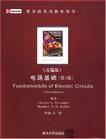电路基础
2008-8
清华大学出版社
(美) (亚历山大Alexander) (C.K) (美)
612
无
《电路基础》由Atexander和Sadiku合著,高歌改编,是一本电类专业本科生学习电路基础课程的英文版教材。 《电路基础》依据教育部高等学校电子电气基础课程教学指导分委员会制定的电路课程教学基本要求,对原版教材作了适当的改编,使之更适合国内学生的学习。 《电路基础》以电路基础知识为主线,着眼于基本分析方法和设计思想,注重前期与后续课程教学环节的衔接,并介绍了计算机辅助分析电路的方法。《电路基础》中重要概念突出,例题分析详尽,使读者更容易理解和掌握知识内容。 《电路基础》的改编过程中征求了熟悉电路教学。具有丰富经验的专家们的意见,准确地把握教材的组织结构.逻辑主线。繁简舍取,深浅得当等要素。《电路基础》篇幅适当。逻辑清晰。层次分明。结构紧凑。叙述凝练。示例有趣。习题丰富,非常适合作为国内高校双语教学用书。
A Note to the StudentAbout the AuthorsPART 1 DC CircuitsChapter 1Basic Concepts1.1 Introduction1.2 Systems of Units1.3 Charge and Current1.4Voltage1.5 Power and Energy1.6 Circuit Elements1.7 tApplications1.7.1 TV Picture Tube1.7.2 Electricity Bills1.8 tproblem Solving1.9 SummaryReview QuestionsProblemsChapter 2Basic Laws2.t Introduction2.2 Ohms Law2.3 Nodes, Branches, and Loops2.4 Kirchhoffs Laws2.5 Series Resistors and VoltageDivision2.6 Parallel Resistors and CurrentDivision2.7 Wye-Delta Transformations2.8 tApplications2.8.1 Lighting Systems2.8.2 Design of DC Meters2.9 SummaryReview QuestionsProblemsChapterMethods of Analysis3.1 Introduction3.2 Nodal Analysis3.3 Nodal Analysis with VoltageSources3.4 Mesh Analysis3.5 Mesh Analysis with CurrentSources3.6 tNodal and Mesh Analysesby Inspection3.7 Nodal Versus Mesh Analysis3.8 tApplJcationsDC Transistor Circuits3.9 SummaryReview QuestionsProblemsChapter4Circuit Theorems4.t Introduction4.2 Linearity Property/4.3 Superposition4.4 Source Transformation4.5 Thevenins Theorem4.6 Nortons Theorem4.7 Maximum Power Transfer4.8 Applications4.8.1 Source Modeling4.8.2 Resistance Measurement]4.9 SummaryReview QuestionsProblemsChapter 5Capacitors andInductors5.1 Introduction5.2 CaPacitors5.3 Series and Parallel Capacitors5.4 Inductors5.5 Series and Parallel Inductors5.6 tApplicationsPhotoflash Unit5.7 SummaryReview QuestionsProblemsChapter 6First-Order Circuits6.1 Introduction6.2 The Source-Free RCCircuit6.3 The Source-Free RL Circuit6.4 Singularity Functions6.5 Step Response of an RCCircuit6,6 Step Response of an .RL Circuit6.7 Applications6.7.1 Delay Circuits6.7.2 Relay Circuits6.8 SummaryReview QuestionsProblemsChapter 7Second-Order Circuits7.1 Introduction7.2 Finding Initial and Final Values7.3 The Source-Free SeriesRLCCircuit7.4 The Source-Free Parallel RLCCircuit7.5 Step Response of a Series RLCCircuit7.6 Step Response of a Parallel RLCCircuit7.7 General Second-Order Circuits7.8 tApplicationsAutomobile Ignition System7.9 SummaryReview QuestionsProblemsPART 2 AC CircuitsChapter 8Sinusoids and Phasors8.1 Introduction8.2 Sinusoids8.3 Phasors8.4 Phasor Relationships forCircuit Elements8.5 Impedance and Admittance8.6 Kirchhoffs Laws in the FrequencyDomain8,7 Impedance Combinations8.8 ApplicationsPhase-Shifters8.9 SummaryReview QuestionsProblemsChapter 9Sinusoidal Steady-StateAnalysis9.1 Introduction9.2 Nodal Analysis9.3 Mesh Analysis9.4 Superposition Theorem9.5 Source Transformation9.6 Thevenin and Norton Equivalent Circuits9.7 tApplicationsAC Bridges9.8 SummaryReview QuestionsProblemsChapter 10 AC Power Analysis10.1Introduction10.2Instantaneous and AveragePower10.3Maximum Average PowerTransfer10.4Effective or RMS Value10.5Apparent Power andPower Factor10.6Complex Power10.7tConservation of AC Power10.8Power Factor Correction10.9Applications10.9.l Power Measurement10.9.2 Electricity Consumption Cost33]10.10 SummaryReview QuestionsProhlemsChapter 11 Three-Phase Circuits……PART 3

无